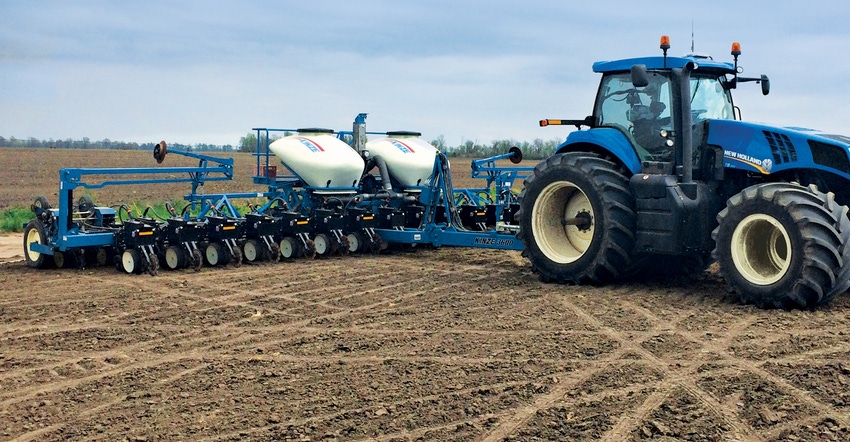
Finally, the weather warmed and soils dried enough so farmers could get into the field last week. Corn planting in Iowa went from zero to 17% completed during the seven-day stretch, according to the weekly survey by USDA’s National Ag Statistics Service. That pace is four days behind the five-year average.
“Farmers in much of the state last week were able to get a good start on planting, and now we have 17% of the corn and 2% of the beans in the ground,” notes Mike Naig, Iowa secretary of agriculture. “Wet soils from the melting snow slowed progress in northwest and north-central Iowa, where less than 5% of the corn is now planted. Statewide, we remain behind the five-year average for corn planting, but hopefully conditions will allow farmers to continue to be in the fields and catch up to normal.”
Greatest progress in southeast, south-central
The greatest progress last week was in southeast and south-central Iowa, where more than 40% of the corn crop was planted as of April 29.
Kurt Hora, past president of the Iowa Corn Growers Association, began planting corn April 24. “A lot of farmers here in southeast Iowa started planting April 23 and 24,” says Hora, who farms in Washington County. “There’s been a lot of progress during the past week in this area of the state. Soil conditions are in good shape for planting. However, there has been a little problem trying to get herbicides applied because it’s been so windy. Winds have been stronger and gustier than normal.”
How are southeast and south-central Iowa doing on soil moisture? “We’re OK now,” Hora says. “But with these winds drying things out, it won’t be too long and we’ll be wanting rain. Forecast is for chance of rain later this week. Maybe we’ll catch some rain.”
Conditions ideal for getting crop planted
Soil temperatures have warmed up. “It’s ideal now for getting this corn crop planted,” Hora says. “Timing is good; conditions are good. We should be able to get the 2018 corn crop off to a good start. I know some other parts of the state aren’t as well off. But hopefully, they’ll get a weather break and get their crop planted quickly.”
While this year’s crop is going into the ground in good condition, it was quite dry in southeast and south-central Iowa over the winter. The snow helped put a little moisture back into the soil. Southeast Iowa also got some rain to help provide needed soil moisture this spring. “But we’re going to need some timely rain during this 2018 growing season,” Hora adds.
The complete weekly Iowa Crop Progress & Weather Report is available on the Iowa Department of Agriculture & Land Stewardship’s website, iowaagriculture.gov, or on USDA’s site, nass.usda.gov/ia. The report summary follows here:
Crop report
Iowa farmers made the most of the 4.7 days suitable for fieldwork for the week ending April 29. The weekly survey by USDA’s National Ag Statistics Service shows that corn and soybeans were planted in addition to soil preparation fieldwork and fertilizer application.
Topsoil moisture levels rated 4% very short, 15% short, 73% adequate and 8% surplus as a statewide average. Subsoil moisture levels rated 5% very short, 14% short, 73% adequate and 8% surplus. South-central Iowa remains dry, with over one-third of the subsoil in that area rated very short on moisture.
Northern Iowa running behind on planting
Iowa farmers planted 17% of the expected 2018 corn crop this past week, three days behind last year and four days behind the five-year average. Northern Iowa remains wet from melting snow, which has slowed planting progress. Northwest Iowa only had 3% of its corn planted last week, with north-central at 2% and northeast at 10%. However, south-central and southeast Iowa farmers already have at least 40% of their corn planted.
Soybean planting is also underway, with 2% of the state’s expected crop in the ground. That’s two days ahead of last year but equal to the average. Looking at Iowa’s oat crop for 2018, 62% of the expected crop has been planted — eight days behind both last year and the five-year average. Just 10% of the crop has emerged, almost two weeks behind last year.
The extended winter season has left hay in short supply for some livestock producers. Pastures in many areas need rain to spur growth.
Weather summary
According to Michael Timlin, regional climatologist at the Midwestern Regional Climate Center, a dry week with only slightly below-normal temperatures allowed many farmers to get into the fields. Most of Iowa received no precipitation during the week ending April 29. Light rains fell April 24-25 in western and southwest Iowa, with about a dozen stations reporting totals over 0.1 inch. The largest precipitation total was in Little Sioux with 0.18 inch, all of it in the morning of April 25. Rainfall amounts were well below normal for late April.
Temperatures for the week averaged near normal or only slightly below normal, on the heels of several cool weeks. Departures from normal were less than a degree from southwest Iowa into the center of the state, while departures of 2 degrees below normal were recorded along the northern border and in the southeast corner of the state. Maximum temperatures were above normal for much of Iowa, and minimum temperatures were below normal.
Soil temperatures had climbed above 50 degrees F everywhere except for a couple of reporting locations in the northwest corner on April 29. Each day during the week, freezing temperatures were reported at some locations. The northeast and east-central areas of Iowa were in the upper 20s on the morning of April 29. The coldest reading in the state was the morning of April 29 in Waukon, at 18 degrees. The warmest readings were the afternoon of April 27, when temperatures rose to 79 degrees in De Soto, Atlantic, Red Oak and Shenandoah.
About the Author(s)
You May Also Like




